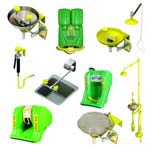Revised Eyewash and Shower Equipment Standard Expected by Year End
Testing and certification sections of the ANSI/ISEA Z358.1 standard have been rewritten to place the focus on the delivery of the flushing fluid.
 The widely-used industry standard for emergency eyewash and shower equipment (ANSI/ISEA Z358.1) is undergoing revision and is expected to by available by the end of 2009 as an update to the 2004 edition. Voluntary consensus standards recognized by the American National Standards Institute (ANSI) are required to be reviewed every five years in part to ensure they are still relevant in the industry, represent state-of-the-technologies and materials, and reflect current test methodologies and use practices.
The widely-used industry standard for emergency eyewash and shower equipment (ANSI/ISEA Z358.1) is undergoing revision and is expected to by available by the end of 2009 as an update to the 2004 edition. Voluntary consensus standards recognized by the American National Standards Institute (ANSI) are required to be reviewed every five years in part to ensure they are still relevant in the industry, represent state-of-the-technologies and materials, and reflect current test methodologies and use practices.
The ANSI/ISEA Z358.1 standard is the definitive document that provides uniform minimum requirements for the performance, use, installation, test procedures, maintenance, and training for emergency showers, eyewashes, eye/face washes, and combination equipment used in the treatment of the eyes or body of a person who has been exposed to hazardous materials. It is accepted on both a national and global basis by engineers, building operators, and regulatory entities responsible for workplace safety.
As part of this revision process, the draft proposal has been circulated for approval by a consensus panel of key stakeholders, including equipment producers, user groups such as hospitals and chemical manufacturing facilities, safety and health officers, and government bodies. In addition, the proposed update is available for public review, allowing any interested party to assess the standard and provide constructive comment that will improve the quality of the document. These reviews are a vital part of the standard development process because the input from the stakeholders often drives the changes and improvements that are included in the final, published revision.
Changes in Key Areas
In preparing the revision, the ISEA Emergency Eyewash and Shower Group considered several key areas of the standard:
- Testing and certification: All equipment for which claims of compliance to the standard are made must be certified by a certification organization. In an effort to provide consistent testing protocols, these sections have been rewritten to place focus on the delivery of the flushing fluid. This is a critical factor to ensure that a person in need can receive adequate amounts of flushing fluid needed to treat an affected area.
- Personal wash units: Personal wash units continue to be recognized as supplemental equipment, intended to be located immediately next to the potential hazard and to be used while a victim is being moved to an eyewash or shower for additional treatment. For this revised document, personal washes are required to meet any applicable regulatory requirements, such as those imposed by the Food and Drug Administration.
- Tepid flushing fluid: The requirement of emergency eyewash and shower equipment to provide tepid flushing fluid has been around since 1998, but it does not define a specific temperature range. The proposed revision attempts to quantify an acceptable temperature for delivered flushing fluid, which is often requested by building engineers and equipment installers.
Copies of the draft revision are available from the ISEA, with the comment period closing on June 22, 2009. For more information, stakeholders should contact ISEA at [email protected].
About the Author
Cristine Z. Fargo is manager, standards programs for the International Safety Equipment Association (ISEA). ISEA is the Secretariat for the ANSI/ISEA Z358.1 standard and several other personal protective equipment standards. Its Web site is www.safetyequipment.org.